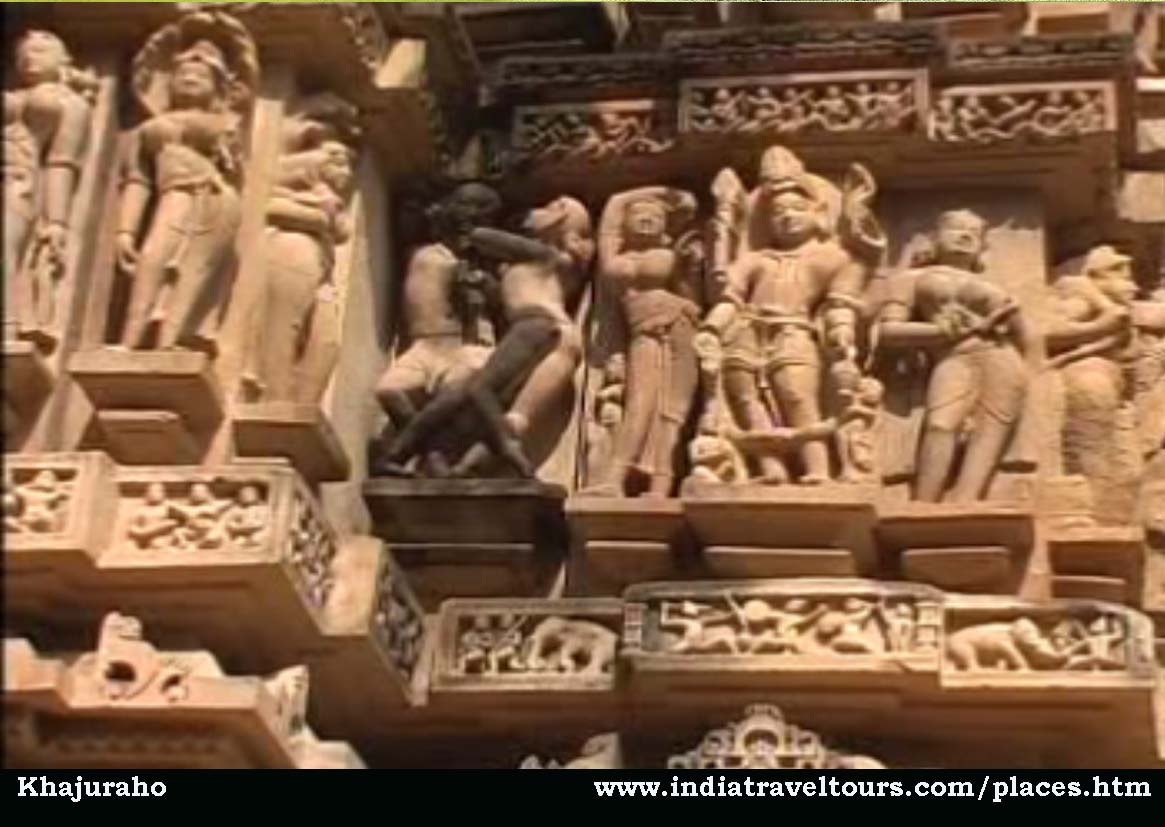India Tourist Places | North India Tours | Khajuraho
 “The Beauty of Khajuraho Temples, Madhya Pradesh Introduction”
“The Beauty of Khajuraho Temples, Madhya Pradesh Introduction”
The Khajuraho in Chhatarpur District of Madhya Pradesh is one of the three most important tourist destinations in India. This sleepy town is located 604 km by direct train from New Delhi. UNESCO mentions the extant 22 Khajuraho temples as a World Heritage Site. Their unique erotic sculptures make them one of the “seven wonders” of India. These temples remain an enigma as their USP is their Erotic Sculptures. However, they continue to mesmerise the tourists, especially from abroad, for their erotic sculptures and perfectly carved figurines depicting the scenes and postures straight from the Kamasutra – the famed ancient Indian treatise on erotica. Archaeological sources indicate that these temples were built by the pre-Islamic Chandel Dynasty during 950 to 1150 AD.
The Khajuraho Temples symbolize the sophistication and splendour of the Sculpting Art forms that flourished around the Tenth century in India. The artistic grandeur and elegance of Khajuraho temples has been praised by acclaimed art historians and connoisseurs alike. This architectural phenomenon of medieval India, before the Muslim invasion, was created by the warrior kings of the Chandela Dynasty, whose reign lasted for over two centuries.
Architecture
Although, there is a popular belief that a total of 85 temples were originally built, but only 22 survive today. These 22 temples are divided into Western, Eastern and Southern groups respectively.
The western group has the largest number of temples, which include the towering Kandariya Mahadev temple, Lakshman temple and Devi Jagdamba temple. The eastern group comprises of Jain temples, named because of the Tirthankar statues installed in the sanctum sanctorum. The southern group includes two temples, Dulahdeo and Chaturbhuj, at a little distance. Though both eastern and southern groups of temples are apparently later constructions, yet the architectural lines are superb.
The Khajuraho temples are made of sandstone probably derived from Panna, hardly 40 kms to the east. One important characteristic of these temples is that mortar is not used as a binding agent. Instead, the heavy stones were put together with help of mortise and tenon joints, which have held place due to gravity. One marvels about the use of the columns which were carved out of megaliths weighing upto 20 tons.
Khajuraho Sculpture
Some of the sculptures in these temples flaunt some candid sexual or erotic acts. Overall, these erotic sculptures are hardly 10% of the carvings found in these temples. Mostly, these suggestive carvings appear outside the temple. Some of the temples have small erotic carvings on the outside. A large majority of other carvings in the temples depict mundane human themes, or routine facets of life. Wherever the carvings portray sexual themes, they illustrate amorous relationship among ordinary people. For example, some representations exhibit women in the act of applying makeup, or musicians, or potters, or farmers, or other such folk.
The Enigma of Khajuraho sculptures as Erotic Art
The most talked about carvings are those which display curvaceous feminine figures in their lifestyle routine, or, voluptuous woman interlocked in passionate lovemaking with equally handsome men.
There have been many theories about the presence of such explicit erotic carvings as temple murals. Some opine that these carvings were meant as a tool for sex education foradolescents; others feel that with all-pervasive Buddhism diverting youth to renunciation, these carvings were a ploy to bring back errant youth. A more philosophical interpretation seeks to highlight the efficacy of “Kaama,” as one of the four fundamental human pursuits, as specified by Hinduism, for the achievement of “Moksha” (liberation from the pangs of transmigration of souls).
However, another school of thought offers this plausible legend. As per this hypothesis, there was once a beautiful young woman Hemavati, the daughter of a Brahmin priest. She was wickedly seduced by the moon god while bathing in the river one evening. The child born of this alliance between a god and an earthly woman was a son, who was later named as Chandravarman. Hounded out by the society, the unwed mother found asylum in the dense forests, where she gave birth to the child. Left to her own devices, she brought upher son lovingly in the forests, where she was also his guru. The boy grew up as a valiant man, who later founded the great Chandela dynasty in Central India. Over the years, the mother expired. Once the king had a vision in his sleep; his mother implored him to build temples to demonstrate the insincerity of human passions, which could make people realize the fallacy of human desire. Chandravarman took up his mother’s command in right earnest and constructed the first of these temples; later rulers added to this growing complex.
Tourism and cultural Activities
The Khajuraho temple complex offers a ‘Son et lumière’ (sound and light show), every evening, so as to make the visit of tourists memorable, by dramatizing the history of these temples, while narrating the events. The presentation is both in English and Hindi.
Apart from this highly popular daily presentation, there is the Annual Khajuraho Dance Festival, organized every year during the 1st week of February. It is a spectacular programme against the backdrop of these temples and presents some famous danseuses presenting their classical dance concerts.
On top of these two, the Archaeological Survey of India presents a fairly detailed commentary as an Audio Guided Tour for some of the temples in the western group of temples.
Excursion
Some additional temptations around Khajuraho are the Panna Tiger Reserve and the Gharial sanctuary at Raneh falls.
Connections
Khajuraho is very well connected by air from Delhi, Agra, and Varanasi, also by direct trains from New Delhi, Agra, Allahabad, Varanasi, and Udaipur, besides direct train and road links from Jhansi.